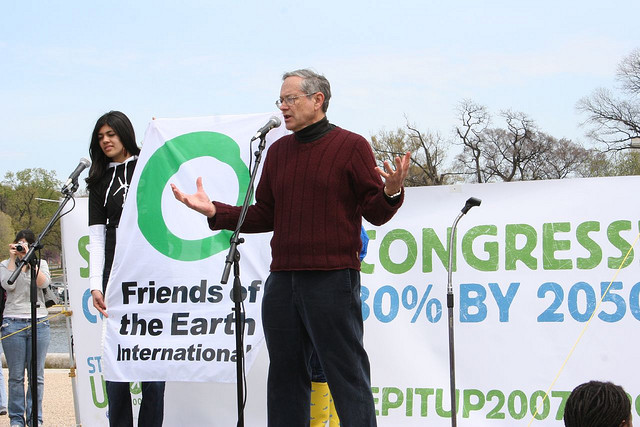Brent Blackwelder, Force of Nature

Brent Blackwelder in action. Photo by Friends of Earth
From June 2013 World Rivers Review
Brent Blackwelder is an icon in the US environmental movement. If his lifelong efforts to protect the planet were an ecosystem, it would take the form of a deep lake (the long history, the many issues, the depth of knowledge) flowing into a swift river (the boundless energy, the fast-flowing thought process, the “lead the charge” attitude). The first Earth Day inspired him to leap into early efforts to protect rivers, legislate clean water, and reform economic drivers that harmed the planet. He’s testified before Congress more than 100 times, was the president of Friends of the Earth for 15 years, helped launch the campaign to reform the World Bank, and helped establish the Green Scissors program, which reveals wasteful and environmentally harmful spending in the US federal budget. He helped launch American Rivers and International Rivers. Today, his “retirement” includes being on the Board for International Rivers (one of eight lucky groups who count him as a board member). Here are some of his thoughts on the state of the world’s rivers and the movement to protect them.
I was born in the Great Lakes watershed, and spent summers near three remarkable waterfalls in a 600-foot-deep gorge of the Genesee River. The entire zone received permanent protection by a local forward-thinking individual after he saw it threatened by logging. I was thrilled to be able to visit this special place. At that time when there were superb fisheries in Lake Erie (the tenth largest lake in the world). By the 1970s, the lake was nearly dead, and filled with algae. It was one of the catalysts for the first Earth Day. These things inspired me to take action.
When we founded American Rivers in 1973, nearly all major rivers had big dams planned for them. The US Army Corps was going to engineer every body of water in the US. A few of us travelled to see the many threatened rivers in the 48 lower states so we could offer first-hand testimony about them. In 1973, the US had designated only eight Wild and Scenic Rivers. Today there are over 250.
The continued protection of rivers and ongoing removal of dams in this country is one of the bright spots in the US environmental movement. In the past 100 years we’ve taken down more than 1,200 dams – a whole lot of them in the past decade – and have defeated more than 200 destructive dam and dredging projects. The US is the world leader in the protection and restoration of rivers.
Developing countries should be looking at adopting some of the language of the Wild and Scenic Rivers Act while they still have some rivers to protect. Because once the dam is underway, it’s really hard to turn it around – sunk costs are our nemesis. The long-term challenge for our movement is to recognize that most important environmental policy is its economic policy.
What I find amazing is, we don’t find nations trying to replicate our current policies of dam removal, Wild and Scenic designations and river restoration. Instead, they’re copying our river engineering policies of 50 years ago. That’s like wanting to replicate the early house-sized computers, or weaponry from World War II. I think every US river group should reach out to grassroots groups working in the Global South, and get more involved in the fight to protect the world’s rivers.
Today we do not have a true-cost economy – all the health and economic costs of destructive projects are shoved off the ledger, as “externalities.” I call it cheater economics. We need to push for an economy that is based on long-term prosperity – and that requires a healthy planet.
We need to recognize the nature of the fight we’re in and develop strategies to prevail. We need more groups willing to get electoral, get in the fray of politics. Coalition building is also extremely important – and it needs to be broad and deep to win.
Locally, we’ve had some good examples of this. For example, the campaign to defeat a uranium mine in Virginia brought together religious leaders, major environmental organizations, and many mayors and local officials from two states concerned about pollution of drinking water from the mine.
In 1976 people concerned about rivers came together to save the Delaware River from the Tocks Island Dam (in a watershed bordering New Jersey and Pennsylvania) and to formulate bigger strategies to save rivers. This gathering of dam fighters in the valley launched what turned out to be ten years of annual dam fighter strategy sessions, mobilizing people from many sectors – land owners, boaters, historians, fisheries people. Not only was the effort successful in stopping the Tocks Island Dam, but it also secured long-term protection scenic river protection for 80 miles of the river. I paddle these portions of the Delaware River to this day.


